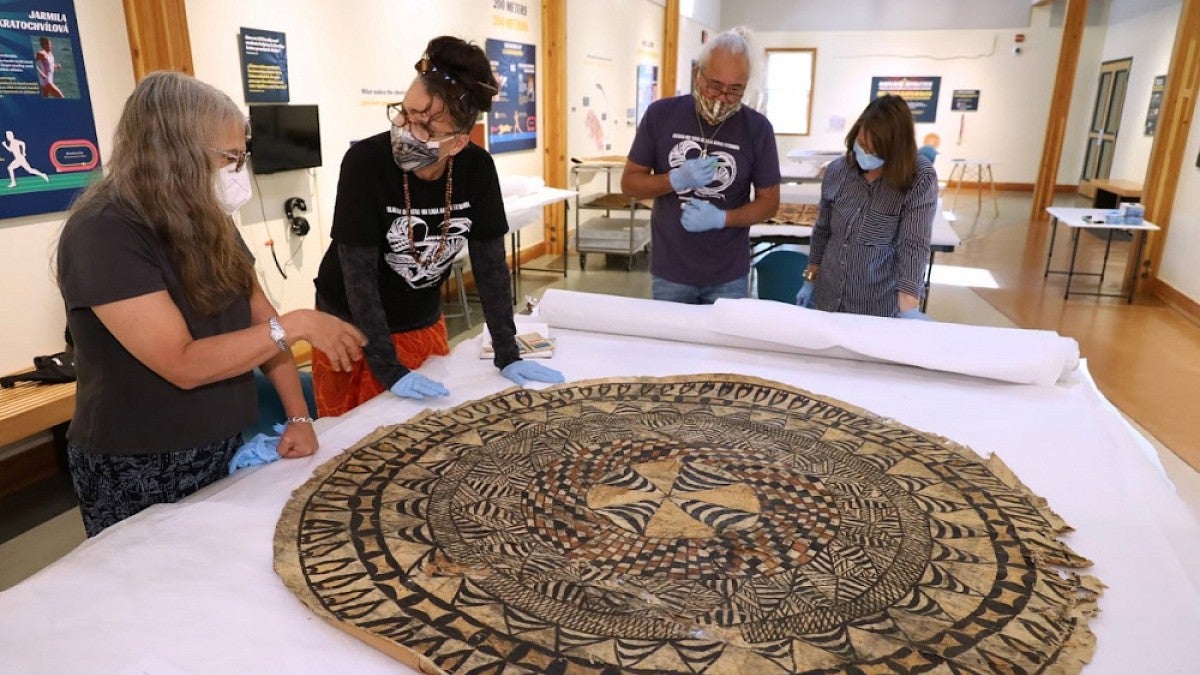A kind of bark cloth known as tapa cloth in Polynesia recently drew a team of Samoan researchers to the UO Museum of Natural and Cultural History to dig into its extensive collection of the culturally important material.
The visit was part of a larger journey to look at collections of tapa cloth at universities and museums across the United States.
“We wanted to better understand how museums present our ‘measina,’ our precious things,” said Regina “Reggie” Meredith Fitiao, one of the visiting researchers. She is a professor of art at American Samoa Community College. Her husband, Su’a Ulisone Fitiao, is an educator and traditional Samoan tattoo artist.
Reggie Fitiao is also a tradition-keeper and renowned maker of tapa cloth, called siapo in Samoa. Tapa is a nonwoven bark cloth central to cultures across Polynesia. It can be used for tapestries, shrouds, blankets, clothing and decoration.
The UO Museum of Natural and Cultural History’s tapa collection is extensive and includes more than 80 primarily from Polynesia, but it includes examples from Congo and Mozambique as well. The museum’s gallery can be viewed online .
The museum was the final stop in the mainland United States for the researchers, who began their voyage in New York City and stopped at more than a dozen museums on their way to Oregon. The group, which included two other members unable to make the trip to Eugene, worked with museums to study the siapo and also provide details that the museums themselves did not have.
Although tapa cloth is most often recognized as a Polynesian craft, it has also been made in South America, Indonesia, Papua New Guinea, Melanesia and parts of Africa.
Making a tapa cloth requires skill and patience. Both Fitiaos learned under the same master, Auntie Mary Jewett Pritchard, who learned from the women of Leone, a village in American Samoa.
Although tapa cloth is still a staple in many Polynesian homes, the practice of making it has diminished over the past century. Due to colonialism in the 19th and 20th centuries, the largest collections of tapa cloths are currently housed in universities and museums in Hawaii, the mainland United States and Europe.
The researchers helped the collections staff at the Museum of Natural and Cultural History identify when the siapo in the collection were likely made based on design and materials. They pointed out outlines of block prints, noting how many times patterns were repeated, and described the 13 elements of traditional Samoan tapa design.
Some of the siapo in the museum collection are round, which is a unique and nontraditional shape. The round siapo likely come from Leone, Reggie Fitiao’s village. One of the round tapa in the museum collections has a Samoan siapo mamanu, or freehand, painting on the front, attached to a tapa of Tongan design on the back. The researchers noted the Tongan tapa was likely acquired through trade.
The Fitiaos pointed out pigments that were introduced by missionaries. One of the vibrant brownish red colors in the mamanu painting was likely Merthiolate, which was originally brought to the island as part of a European medical kit and also became valuable as a dye. The round siapo was probably made as a table decoration, they said.
“These are not made with traditional Samoan designs,” Reggie Fitiao said, pointing out the different leaf patterns on the museum’s collection of round siapo. “The designs diversified with Western motifs after the missionaries came to American Samoa and stayed.”
Designs are still diversifying. When COVID-19 scuttled plans for a trip to European museums in 2020, Reggie Fitiao began making elaborately decorated tapa cloth face masks. She donated one of these masks for the museum’s collection.
As Reggie and Su’a Fitiao teach the next generation of artists and continue the practice of making siapo and traditional tatau (the word for tattoo comes from Samoan), fewer people practice the art of making siapo than they were a century ago.
“Only a handful of us are doing siapo these days,” she said.
“These days, it’s a high-tech world. We don’t use tapa as much anymore,” Su’a Fitiao said. “We found that you guys, museums, kept the tapa safe for more than 100 years.”
“We are ever grateful to institutions that have collections because we wouldn’t see this on our homeland,” Reggie Fitiao said. “We want people to fall in love with our material culture, and also with museums. We want people back home to know that work in museums can be a rewarding career for our young people who have interests in this field as a career.”
—By Lexie Briggs, Museum of Natural and Cultural History


